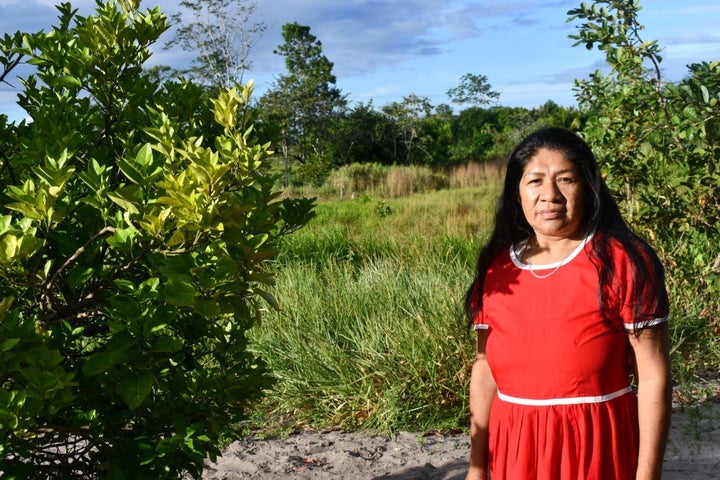Deforestation rates are significantly lower in forests protected and governed by Indigenous people, according to a new report.
The finding comes from an analysis of more than 300 scientific studies on forests in Indigenous and tribal territories in Latin America and the Caribbean over the last two decades.
The report — published Thursday by the U.N. Food and Agriculture Organization (FAO) and the Fund for the Development of the Indigenous Peoples of Latin America and the Caribbean — found that, on average, forests in Indigenous and tribal territories have been much better conserved than other forests in the region.
From 2006 to 2011, Indigenous-controlled forests in the Peruvian Amazon reduced deforestation by twice as much as other protected areas in the region, according to the report.
In the Amazon Basin, home to at least 10% of the world’s known biodiversity, levels of forest destruction in Indigenous territories from 2003 to 2016 were lower than in other protected areas. Indigenous territories cover a total of 28% of the Amazon Basin but account for only 2.6% of the carbon emissions, the report found.

Forests are huge carbon sinks and vital tools in holding back the climate crisis as well as stabilizing regional temperatures and rainfall patterns. Indigenous territories hold roughly one-third of all the carbon stored in the forests of Latin America and the Caribbean, and 14% of the carbon in tropical forests around the world.
“Indigenous peoples and Afro-descendants in the forest areas of Latin America have done a great job of taking care of their forests,” said David Kaimowitz, manager of the forest and farm facility at FAO and lead author of the report.
These communities, with generations of experience successfully protecting nature, have strong track records of guarding the forest, according to the report. They generally favor smaller-scale, more diverse farming, which extracts far less from the land than industrial operations do.
But they are under constant threat from the effects of climate change as well as incursions by industries such as beef, soy, palm oil and fossil fuel production, as well as mining and logging. These threats have increased as road construction makes forests more accessible, and technological advances make mining and farming in remote areas easier. In the meantime, some governments have reduced support for Indigenous land rights.
Cecilia Rivas, the “captain” of the Kariña women, a small Indigenous community living at the heart of Venezuela’s Imataca Forest Reserve, has been working relentlessly to protect her community. For decades, the Kariña people, like other Indigenous communities in the region, have watched industry invade their forests for mining and logging.
“The forest provides us food, water and gives us a roof. It’s not something alien to us, but another living being,” said Rivas, who’s also been working to promote gender equality in the agroforestry sector. “We only take what we need, nothing more.”
To protect the forests, governments and industry need to listen, she said. “Before taking any action, the voices of the Indigenous peoples who inhabit the forests must be heard. Our point of view is the one that should guide each project carried out in our territories.”

One example of this is an Indigenous-led initiative Rivas has worked on with the help of the Venezuelan government and FAO.
In 2019, the Kariña women founded Tukupu, an Indigenous women-led forestry company, named after a tiny, striped fish native to the forest that has been endangered by industrial threats. The government granted them 7,000 hectares (17,300 acres) of the Imataca Forest Reserve, which became the heart of restoration efforts to revitalize areas destroyed by logging and mining. The women have cultivated hundreds of nurseries to grow plants for reforestation, and the company is also working to revive the tupuku fish population.
“We need to center and take direction from Indigenous and tribal earth defenders in order to protect forests’ biodiversity and even prevent the next pandemic,” said Ada Marisol Recinos of the nonprofit Amazon Watch, who was not involved in the report. Scientists have found that deforestation and the destruction of biodiversity increases the risk of pandemics by creating conditions for dangerous pathogens to spread to humans.
“This scientific consensus [in the report] gives our world’s leaders a mandate to defend the rights of Indigenous and tribal communities,” said Recinos. “Otherwise, sensitive biomes and rainforests, such as the Amazon, will remain under threat or, worse, reach an irreversible tipping point.”
The report has a slate of policy recommendations for governments and international organizations, including giving territorial rights to Indigenous people, compensating them for the environmental protection they provide and supporting them to promote and develop sustainable forestry.
“The pressures [Indigenous people face]... are growing at such a rate that they need more external assistance than they’ve needed in the past,” said Kaimowitz, “so the report is also calling on the international community and governments to act and do specific things that we already know work.”
The report’s strongest policy recommendation is for governments to formally recognize Indigenous land rights and ensure respect for them. The report found that from 2000 to 2012, deforestation rates in Indigenous territories with land titles in the Bolivian, Brazilian and Colombian Amazon were one-third of those in ecologically similar forests.
Securing the land rights of Indigenous people is “an efficient and cost-effective way to reduce carbon emissions,” the report concludes.
Other recommendations include tackling the grinding poverty in many Indigenous communities through payment-for-conservation programs, examples of which are already running in parts of Latin America and the Caribbean, including in Mexico, Costa Rica, Guatemala and Ecuador.
In 2008, Ecuador’s government launched the Socio Bosque program offering financial incentives to local and Indigenous communities to protect forests and reduce emissions over a 20-year period. Nearly 200 communities have received payments to conserve about 1.5 million hectares (3.6 million acres) of the forest so far in a program that’s designed to combine conservation and poverty alleviation. Areas of Ecuador where Socio Bosque has been implemented saw about an 80% decrease in deforestation rates from 2008 to 2016.
“If we invest money and if we make the policy decisions that we need, these communities will thrive, and our climate will benefit and biodiversity will benefit,” Kaimowitz told HuffPost.
The report comes at a time of renewed focus on drastically reducing emissions to solve the climate crisis. In April, U.S. President Joe Biden will host his first climate summit, when he’s expected to strengthen the country’s commitments to the Paris climate agreement in advance of the 2021 United Nations Climate Change Conference in Glasgow in November. Biden has also committed to protecting 30% of U.S. land and oceans by 2030.
Kaimowitz said he hopes the report will encourage world leaders to make Indigenous voices and solutions a centerpiece of their commitments to save the planet.
“We looked at the region as a whole. We looked at the overall trends. We identified what it is about these Indigenous and Afro-descendant cultures and other factors that has allowed them to be the guardians of the forest,” he said. “The fact is it’s not a fairy tale. It’s science.”
